If you want to skip directly to the next part, then just hit
Part II
Introduction
This is an abridged description of a trip to Shanghai in October 2010. The intention is just to give a firsthand personal experience of how we, Petra, Uli, Joy and I, traveled to and around that place.
This time I booked in advance not only the flight but also the accommodation in Shanghai, because it was EXPO time.
Since this is not only a travel report but also a personal memory album so don't complain that all or one of us are often standing or sitting in the way while taking the photos.
How to get from Berlin (or Hamburg or Manila) to Shanghai
There are many ways to get there. It all depends on whether Shanghai or China is the main destination for the whole trip or part of an itinerary.
For us it was just a short hop from Manila to Shanghai with the
Cebu Pacific Airline.
I booked the trip online for Joy and me. My roundtrip fare was 190 Euro but for Joy it was 220 Euro, because Philippinos are charged a travel tax. Don't ask me why. Maybe Philippinos should spend their money rather in the Philippines or the government thinks if one of its citizen can afford to travel abroad they also can a little be extorted.
Petra and Uli, however, had to book their flight from Germany in order to get to Manila in the first place. They paid 899 Euro per person for the roundtrip with Emirates from Hamburg via Dubai to Manila. It may have very well cost the same if they would have booked Shanghai with Emirates, but then we could not have flown together. I recommended the travel agent
Kirschner Reisen
Apostelnstraße 11
50667 Köln
Tel.: 0049 221 9201 9201
Email: info@kirschner.de
www.kirschner.de
|
where they booked all their flights, including the ones from Manila to Shanghai with Cebu Pacific. However, they did charge 230 Euro for the roundtrip ticket instead of 190 Euro.
We tried to book online, but because of the international flight we very unable to do so (of whatever reason). Also, we could not wait for a promo fare, because working class people like Petra and Uli must plan very well ahead for their vacation to make sure to get a seat. If we could have been flexible, we could have waited for a promo which really came up a couple of weeks later for around half the price.
Another thing you need beside a ticket is a visa. It's a must. Also to apply in person (may be any person, like an agent) at the Chinese Embassy. Joy and I needed a whole day to apply and another half a day to pick up the visa in Manila. I paid 24 Euro and Joy paid 29 Euro (Philippinos are supposed to be richer?).
It was even more complicated for Uli and Petra to get a Visa for China. They had to travel to the Embassy in Berlin, just to find out that they had forgotten their passports as soon as they arrived. Eventually, they could get an agent to do the visa procedure for them via mail.
Finally we left Manila on time at 8 p.m. without any problems. But before we did eat enough for dinner in the airport, because there is none being served on the plane, though you can buy some ready mix soups or dry sandwiches.
Arrival in Shanghai
We arrived at the Pudong International Airport at 11:45 p.m. Not a very convenient arrival time. Not many people around. No lines anywhere. Passport Control was swift.
I changed 400 Euro and did get 3,357 Yuan. That's 8.39 Yuan for 1 Euro. With my Visa Card I did get 9.26 Yuan for 1 Euro at any ATM later on. So I lost 37.50, almost 10%. So do not change too much or nothing at all at the exchange booth at the airport. Better use your Visa Card, especially if you will not be charged any fee like me. In the following I will not state Yuan but Euro only by using the ATM exchange rate at that time.
Arriving at the Phoenix Hotel
Actually, we did not need any money for transport from the airport because I had ordered beforehand via email a van from our hotel to pick us up at midnight for 21.60 Euro, which be paid next day. After around 30km we arrived at our
Phoenix Hotel
17 South Yunnan Road
Shanghai, 200433
Tel.: 862163288680
Email: phoenix.shanghai@gmail.com
|
which we booked very well in advance through
www.hostelbookers.com.
Our Private Double Ensuite did cost 36,28 Euro per night. Only a 10% deposit had to be paid in advance and no service charge. The remaining balance for the whole stay of 7 nights we paid at check-in.
It turned out that we have chosen the right accommodation. Look up the comments at the hostelbookers site. There you also get a map of the location of the hotel. Before we went to bed we had a late night dinner in a restaurant almost next door at 2 a.m. First surprise about the price: meals for four including beers and sprites for 19 Euro.
Click the small picture to get it enlarged

| Front of the Phoenix
|

| with restaurant beside
|
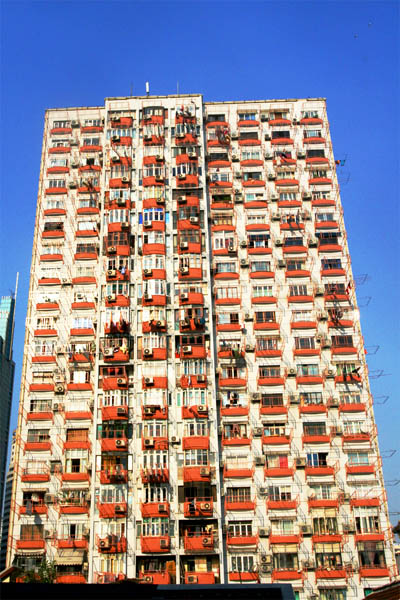
| View from our room
|
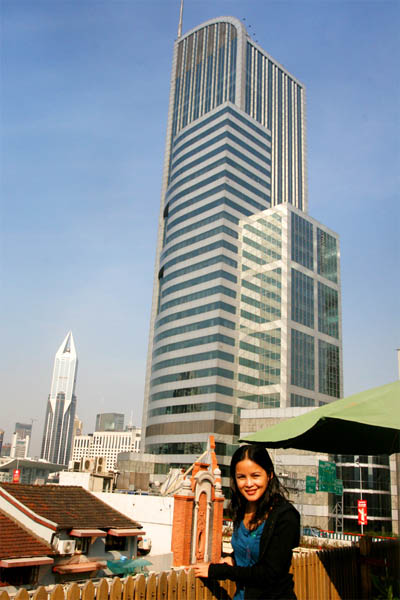
| View from the rooftop
|
Our neighborhood
After a good half a night sleep we did not eat breakfast on the rooftop (slow service to fix a sandwich for 90 Cents and expensive coffee for 1.60 Euro), but a French Bakery in the same street was a little cheaper: One cappuccino for 0.98 Euro and a Danish for 44 Cents. Slowly we experienced that Shanghai is getting more expensive. It almost catches up with Hongkong and Singapore. After our sweet breakfast (we couldn't get an American breakfast around here) we went and looked around to get acquainted with our neighborhood.
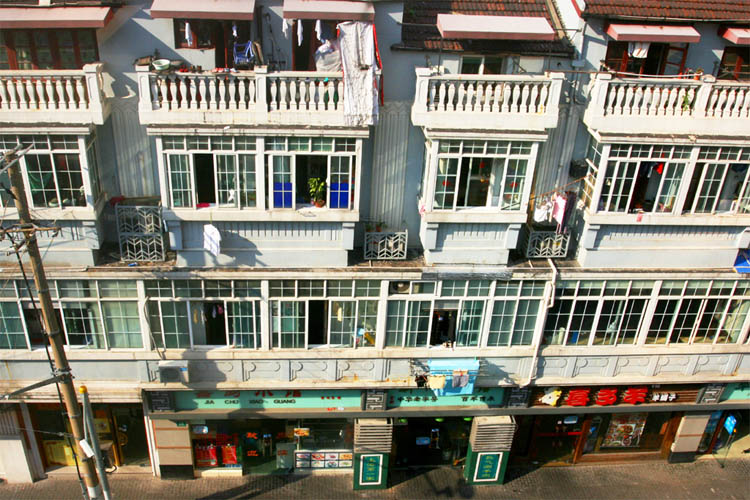
| House opposite the Phoenix
|
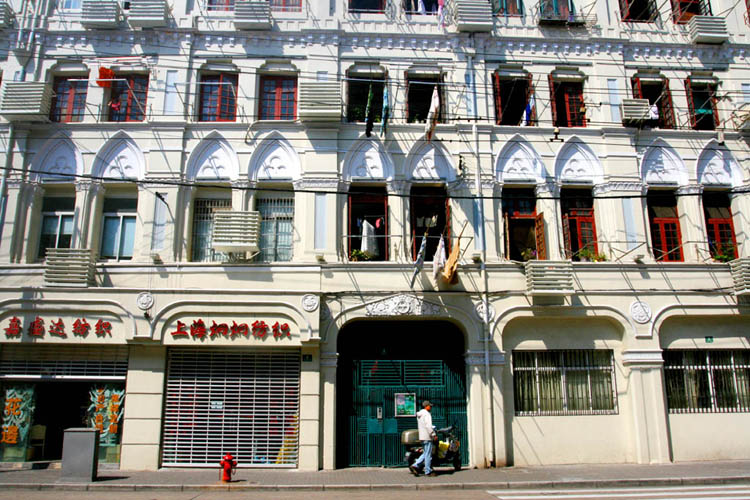
| Another house in the vicinity
|
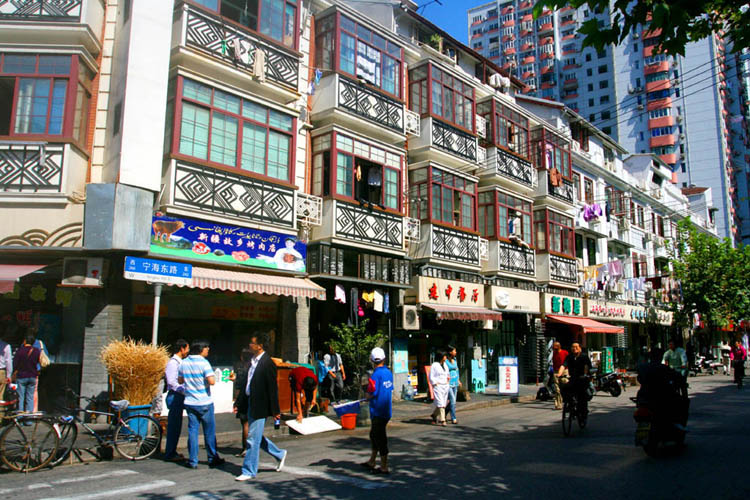
| Our neighborhood
|
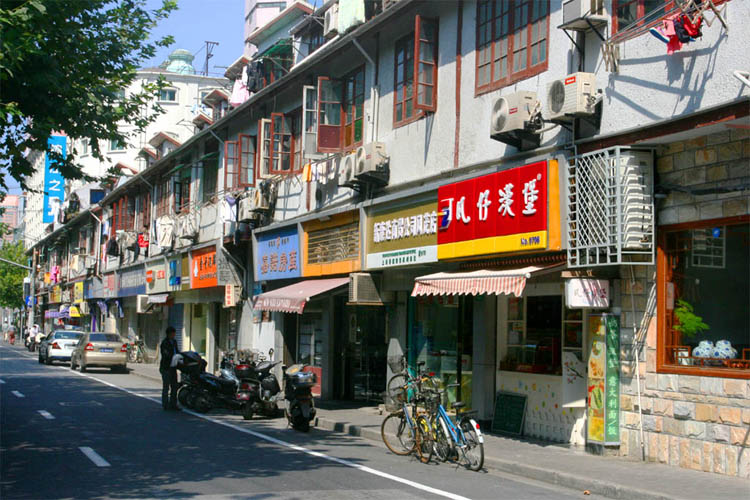
| with shop after shop
|
Some restaurants around
Also the surrounding restaurants had to be inspected. Fish was Joy's and mine favorite food for dinner but not necessarily frogs or toads, not to mention snakes, which were also available. It was a pity that Petra and Uli do not even eat seafood at all, so we had dinner in separate restaurants on some occasions.
Ok, seafood is always more expensive like everywhere. Once we had salmon, prawns, veggies, rice, beer and sprite all for two for 19.50 Euro. For comparison: dinner for two but no seafood at the Phonix including beverages came up to 5.40 Euro. A big bottle of Chinese beer was always cheap between 1.00 and 1.60 Euro.
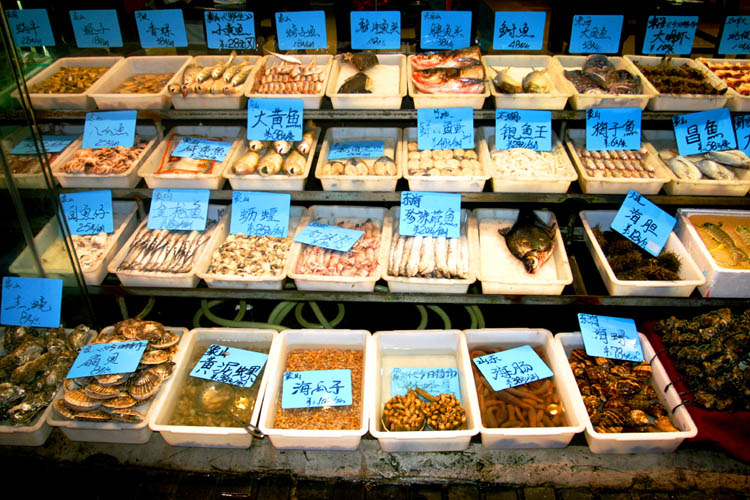
| Seafood restaurant
|
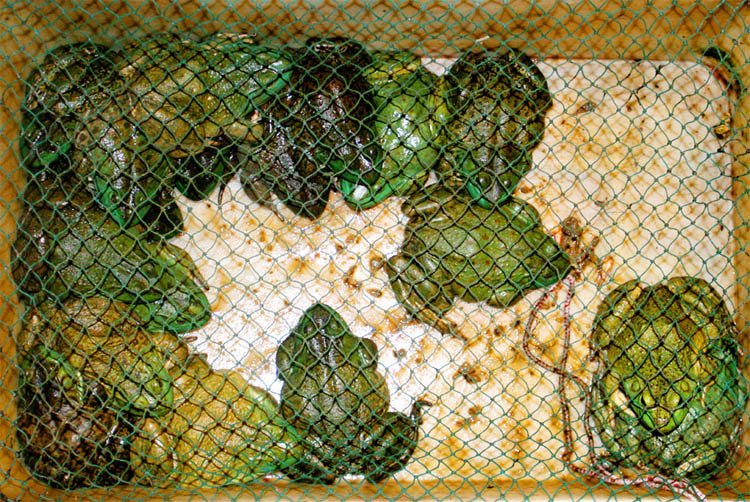
| also offers toads to eat
|
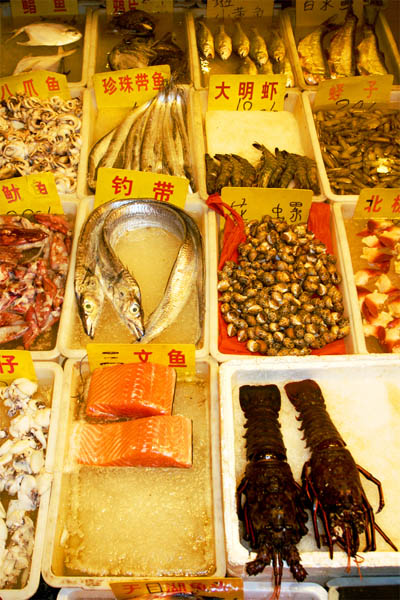
| More sea creatures for sale
|
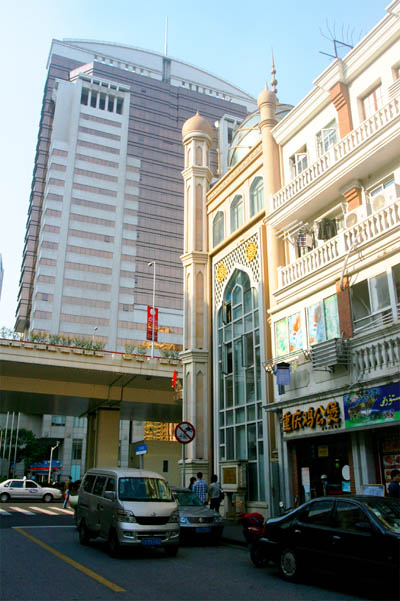
| Fine restaurant in mosque style
|
Walking down the streets to the Bund
We were really energetic and full of action and thus decided to walk to the Bund, which was in easterly direction. From our middle age Shanghai neighborhood we walked along new streets lined by modern high-rise buildings until we reached the Bund.
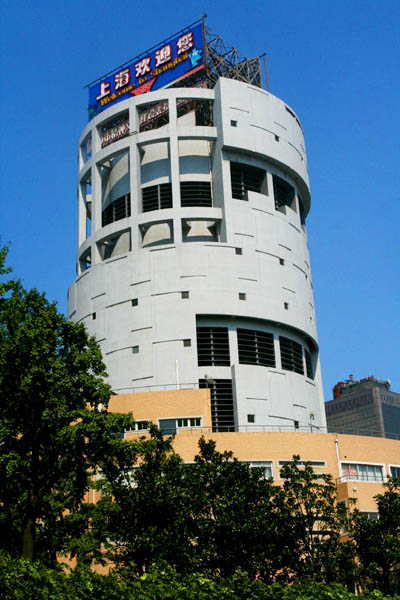
| Nice modern archtecture everywhere
|
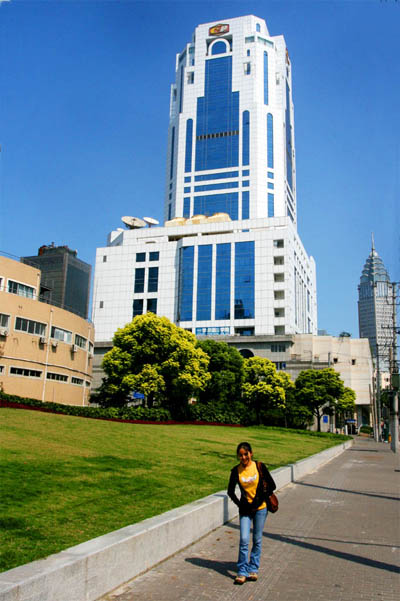
| Buildings you cannot see elsewhere
|
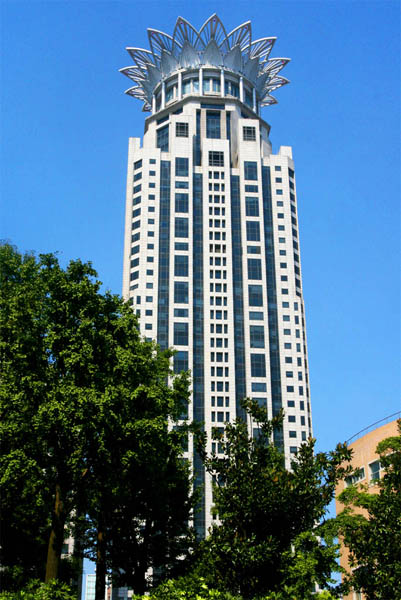
| New skyscrapers at every corner
|
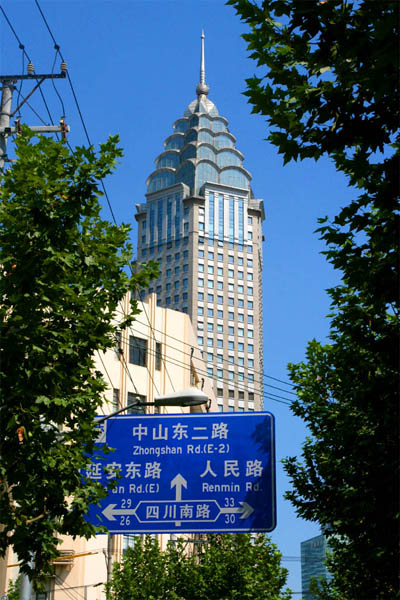
| in the city of Shanghai
|
Getting closer to the Bund. What is a Bund? A Bund is derived from Hindi and means embankment and was introduced by the British (thus pronounced "bunned"). So it was: the bank of the river Huangpu. Many old buildings lining the Bund were constructed in the 20th and 30th of the last century during the colonial era of Shanghai (some call it the decadent heydays). Despite the fact that the Chinese do not want to be reminded of the humiliation done by the foreign powers (like at some places Chinese were not allowed), they are now proud of their Bund.
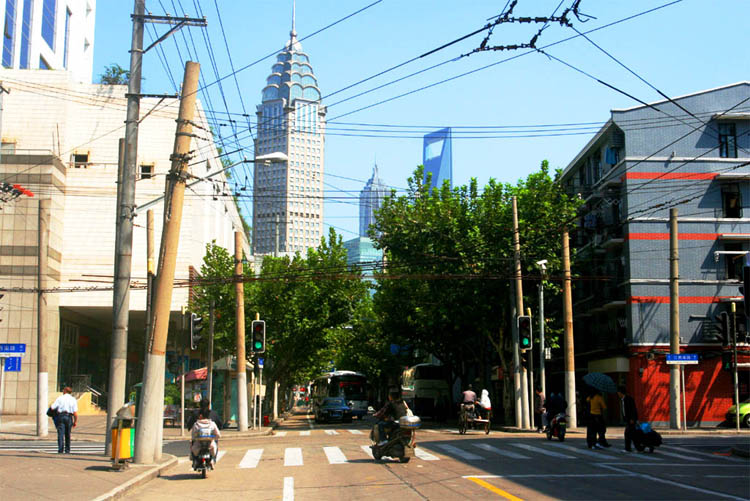
| Getting closer to a famous area
|
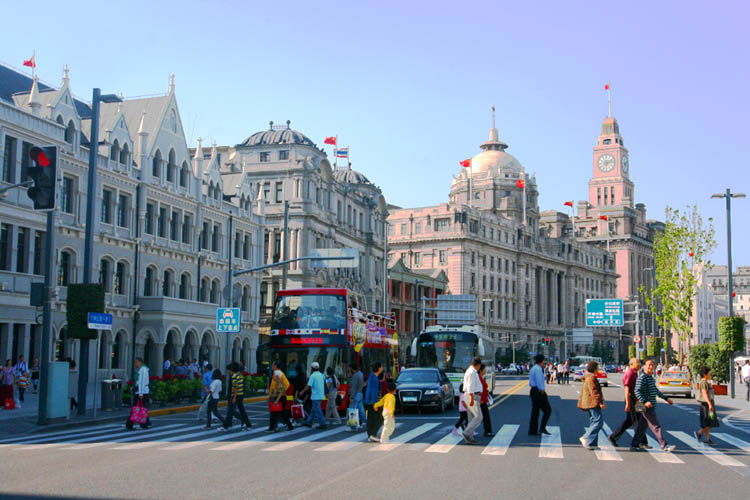
| called the Bund along the river
|
Walking on the Bund Promenade
Seeing the Bund and die? Not necessarily. But missing the Bund is like visiting Beijing and bypassing the Great Wall. So is the saying. But for me it was more interesting to look from the Bund to the other side of the river: to Pudong.
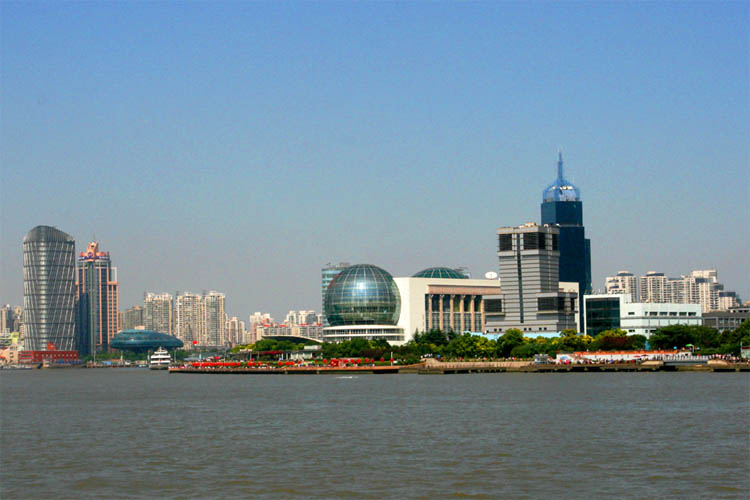
| From the Bund looking left
|
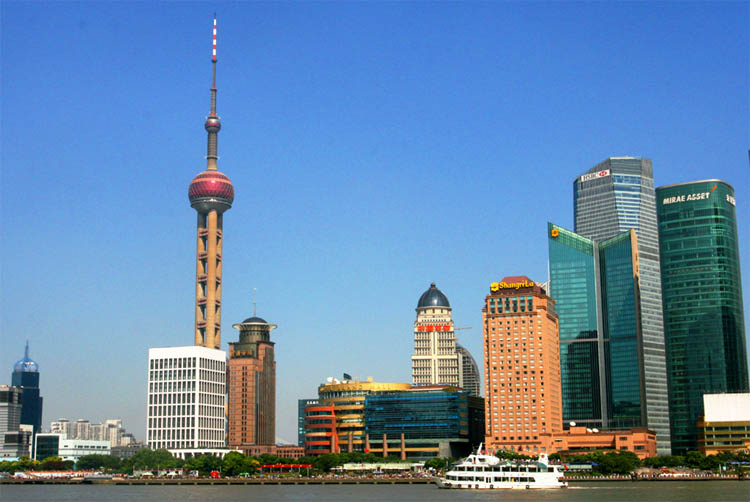
| then roaming to the right
|

| Then farther right
|
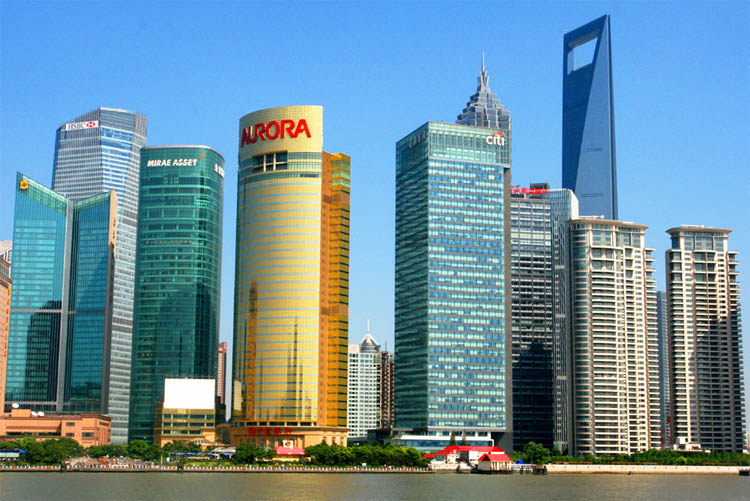
| and more to the right
|
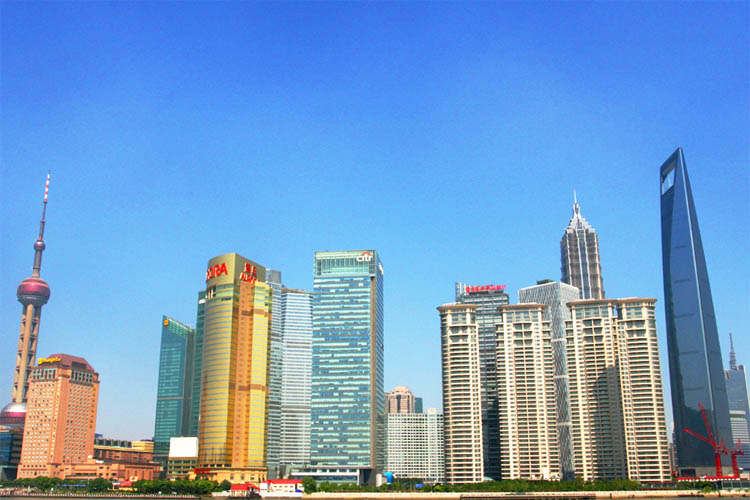
| This is the best panorama
|
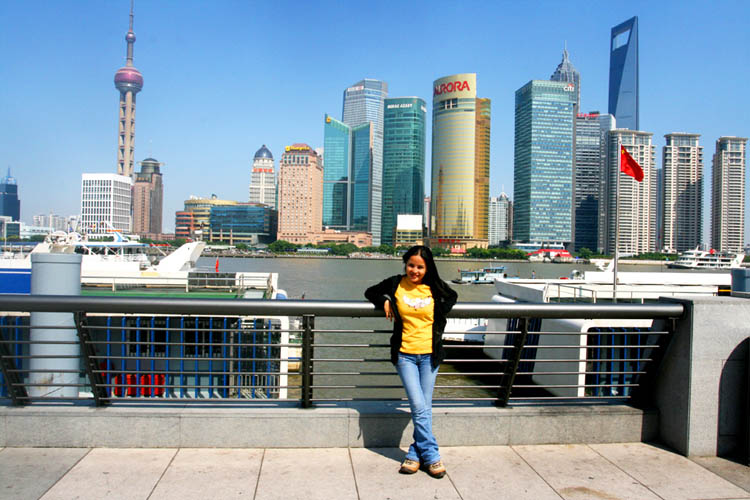
| and the best in the middle
|
Can you imagine: Around 20 years ago there was nothing but farmland on the other side, in Pudong. Can you imagine: Less than 20 years were needed to build all those skyscrapers (3000 of them) and more and more (you will see more later on from above). Can you imagine: How long would any European country need to build a city like that?
What has Berlin built within 20 years since the fall of the wall (with repairs already starting)? Ok, we do not want that. Right? We do not want to lose our good working conditions achieved through the unions. But there is still a cheap Chinese workforce available 24 hours a day and 7 days a week to finish a skyscraper in the shortest time possible. OK, there is actually no need to catch up with building or extending cities in Europe like that.
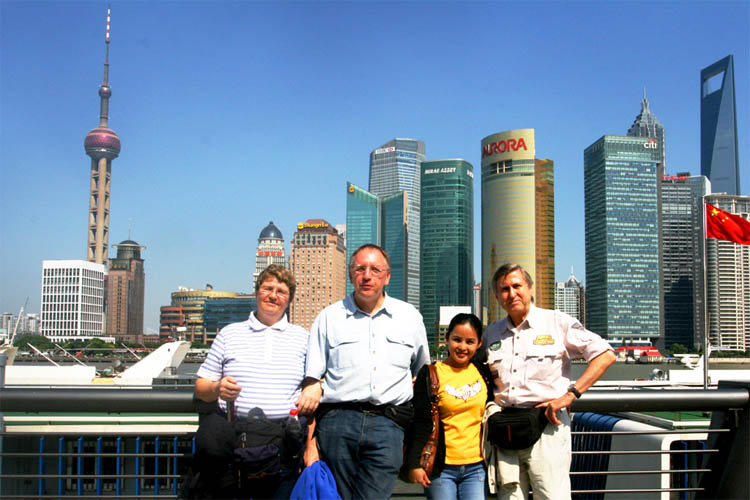
| Chinese photographer cut our legs
|
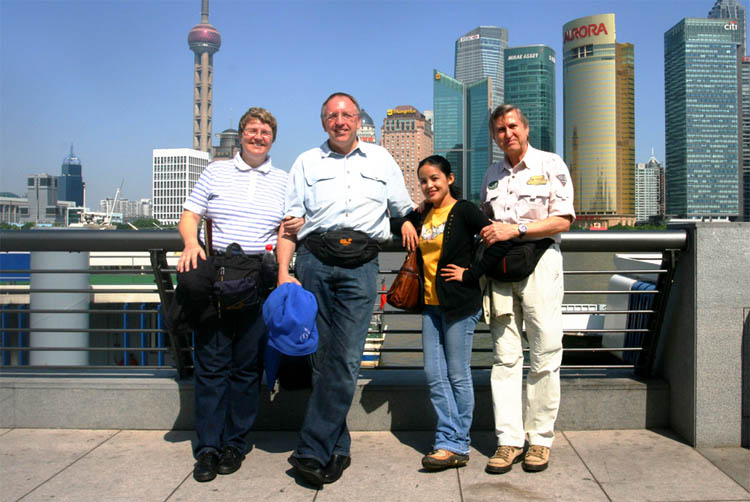
| after instruction it was almost perfect
|
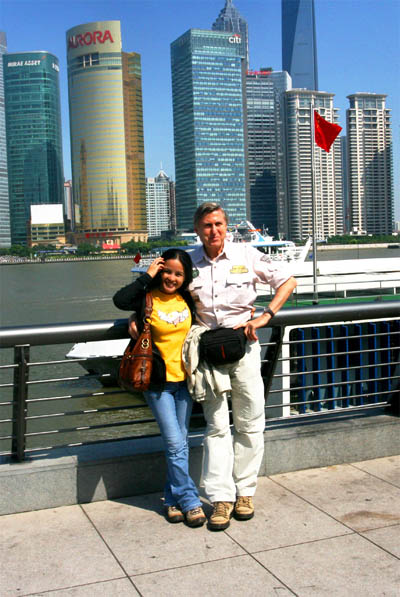
| Aren't we perfect, too?
|
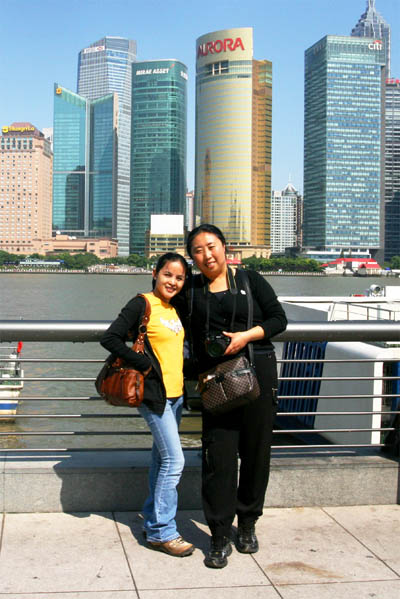
| So is the Chinese-Philippine friendship photo
|
You may wonder why there are not that many people walking around. Even the elevated riverside promenade of the Bund was not overcrowded. Where are all those 20 million inhabitants of Shanghai and the masses of tourists? They seem to be evenly distributed all over the city. Either most stay home or are at work or are underground, i.e. in the Underground or Subway, called Metro in Shanghai, carrying 3 million passengers daily. Our Metro experience will be described in Part II.
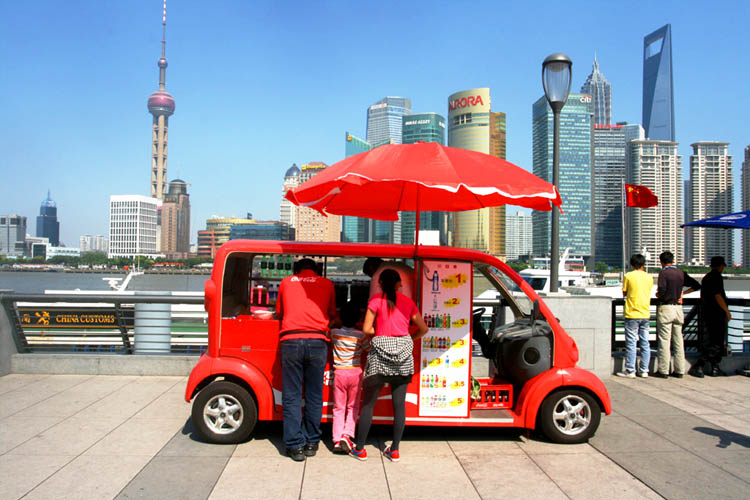
| Ice cream car
|
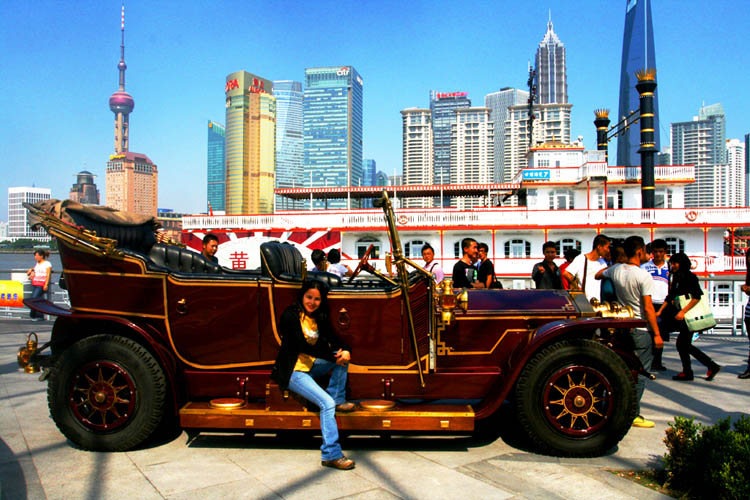
| Hot fudge car
|
Many boats and ships, in many different designs, are moored along the riverbank, scheduled for various river cruises. On the other side of the river you see more and more buildings of Pudong.

| Hot speed boat
|
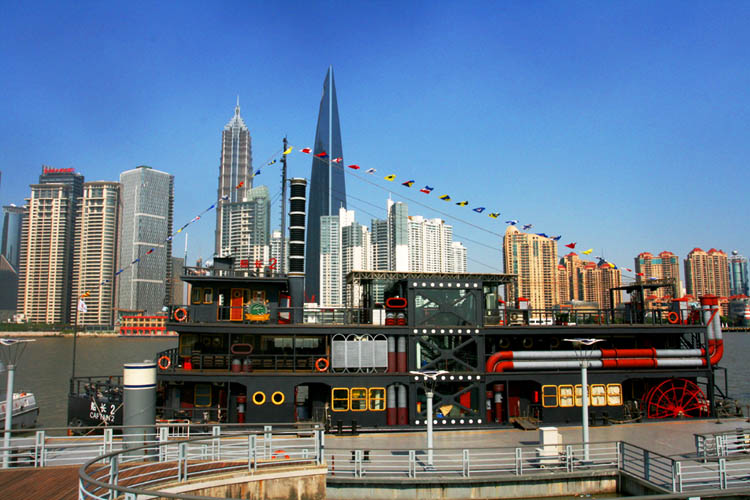
| Hot wheel "steamboat"
|
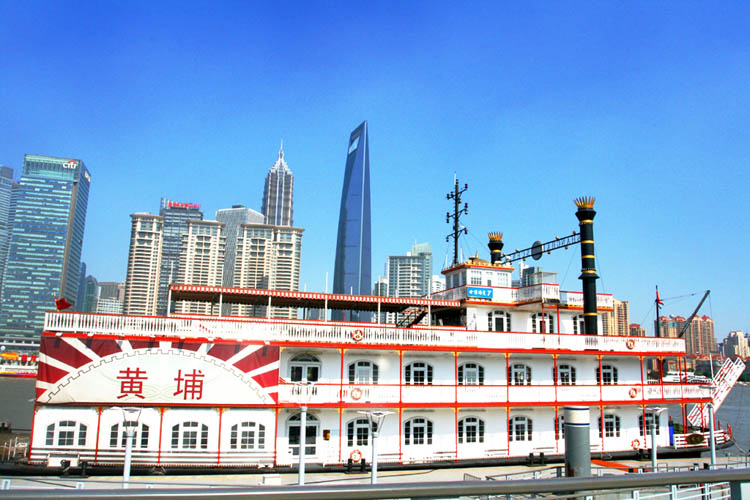
| Paddle-Wheel "steamboat"
|
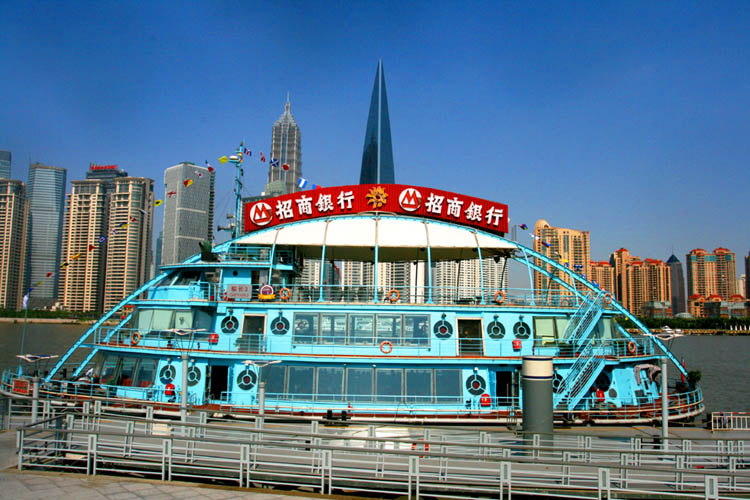
| Very funny "steamboat"
|
Following is a first close look up at the new Shanghai World Financial Center Building (Uli called it the "Bottle Opener"), which we will visit and explain more in Part II. The old Meteorological Signal Tower at the Bund (which houses the Bund Museum) is much smaller and cheaper to get in (free admission) but with expensive drinks at the bar on the second floor.
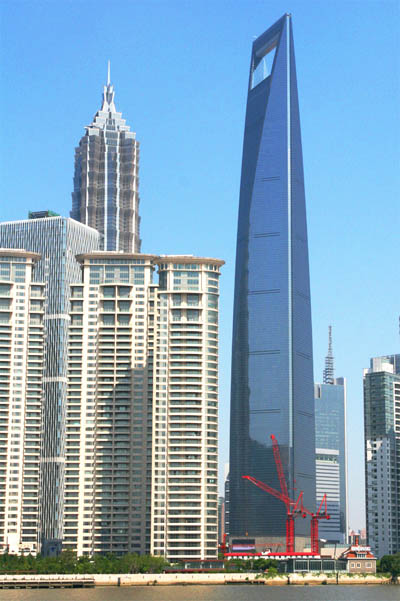
| "Bottle opener" tower
|
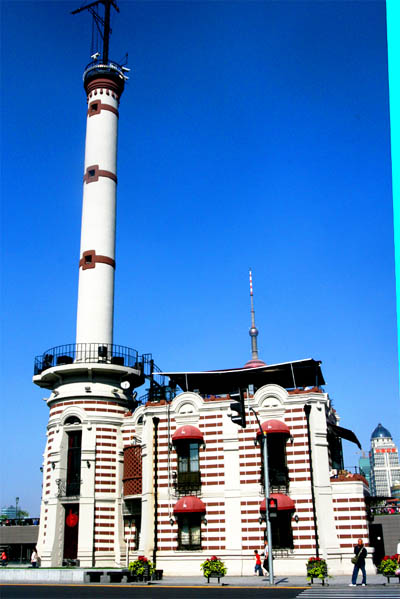
| Meteorological Signal Tower
|
Visiting the EXPO
Ok, the next day the EXPO was on our agenda. The taxi took us to the entrance of the EXPO on the other side of the river, which was the main exhibition site. The fare was around 4 Euro for the 15km or so. Taxies are cheap with 1.30 Euro for up to 3km, and comfortable too. Even some had a video screen.
Most taxies are Santanas based on the old VW Passat and build in a joint venture plant. So there is not much new technology know-how to steal. Western companies are not that stupid. Hi-Tech cars are still being built in Germany and rather exported. Chinese are buying imported Mercedes, BMWs, Porsches like crazy now. But the day will come when the Chinese can build a state of the art Mercedes engine themselves.
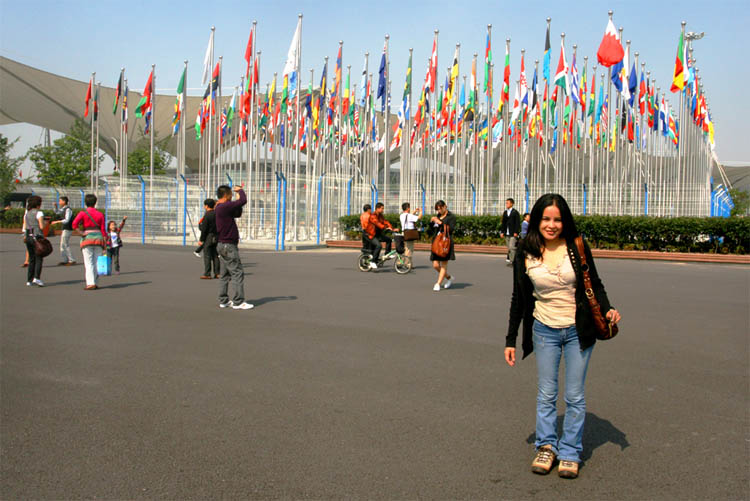
| Country flags EXPO 2010
|
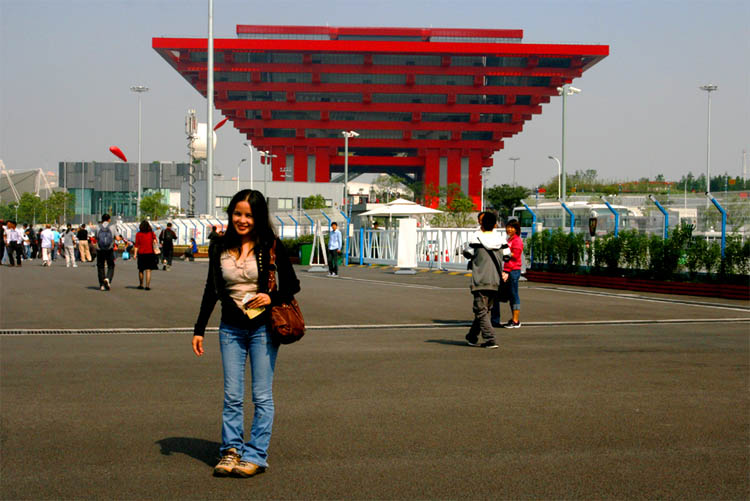
| Chinese Pavilion
|
An EXPO as a one-time event should not be part of a travel report, even if many of these pavilions may still be there. Thus I have created the separate link
EXPO 2010.
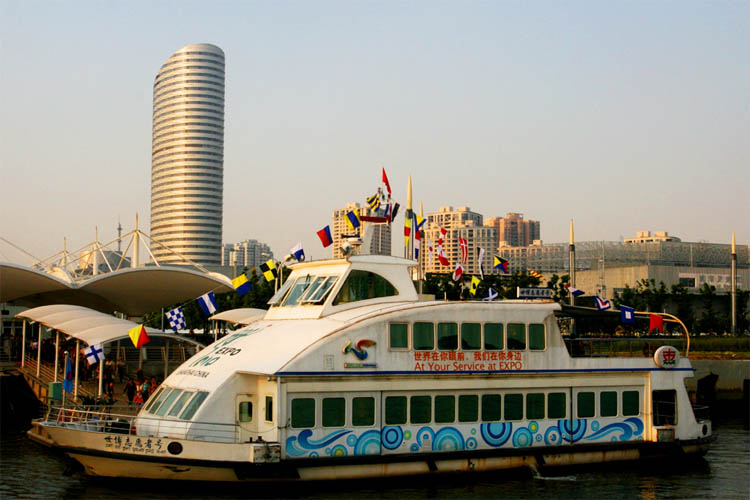
| Free shuttle ride
|
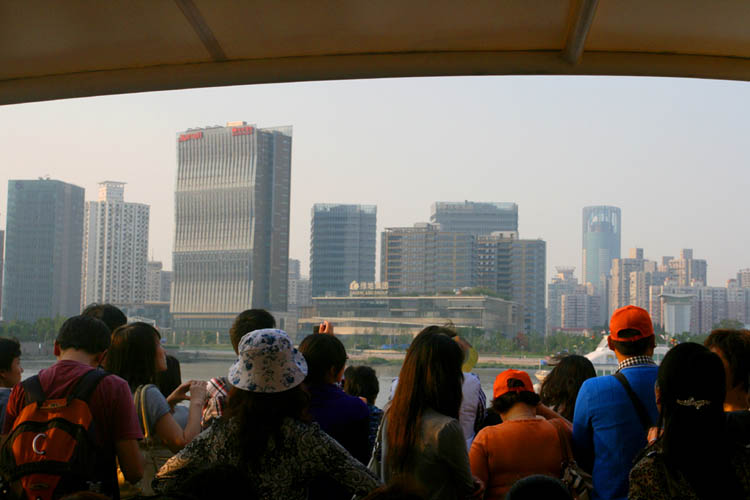
| to the other side
|
The Huangpu River
While crossing to the other side of the EXPO site we had a glimpse on and from the river to the Lupo bridge, which we crossed when we were coming from the Pudong airport.
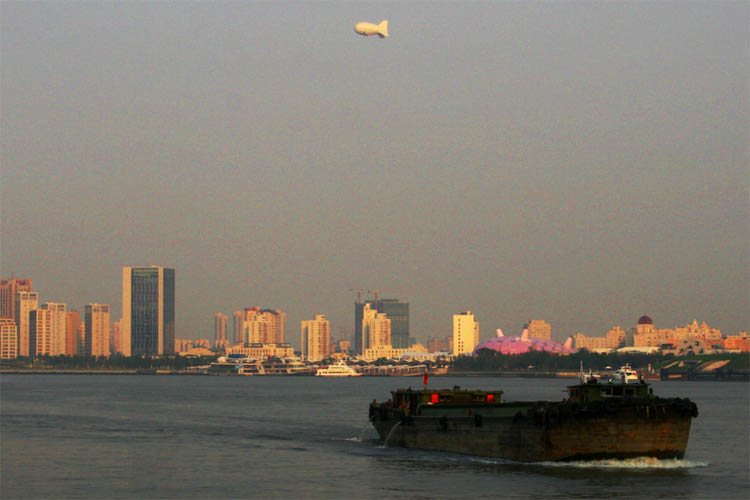
| Looking back and
|
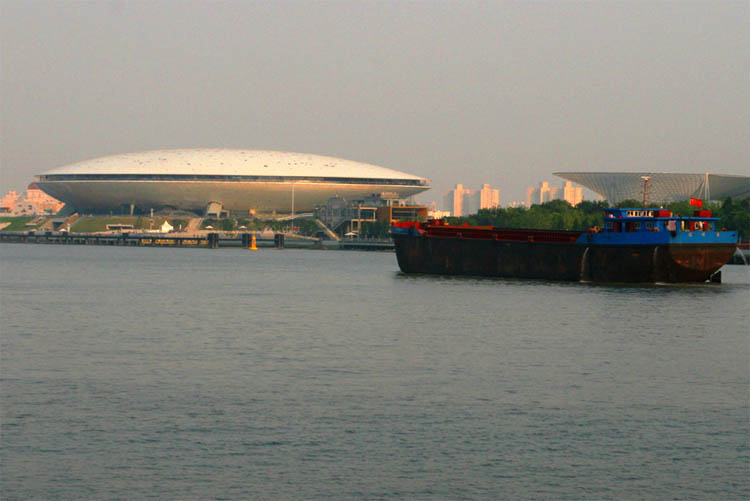
| into the future
|
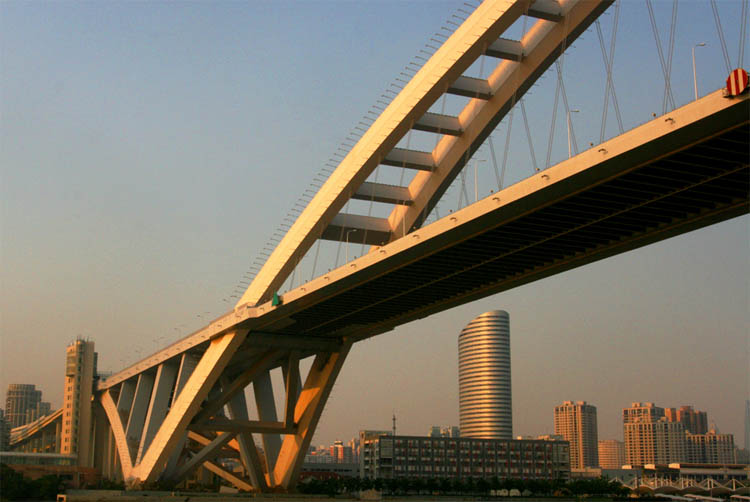
| Modern Lupo Bridge
|
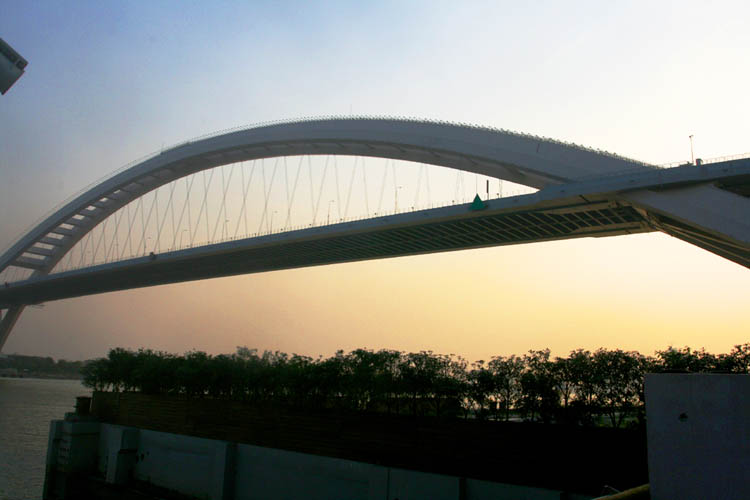
| over the Huangpu River
|
Back in our street
Back in our street we did get a massage for our feet. What a relief after walking around a whole day. And we had to be fit for the next day. Ok, the shoe shine offer was not today but tomorrow after another walk whole day which we did not need but rather another massage of our feet in our street.
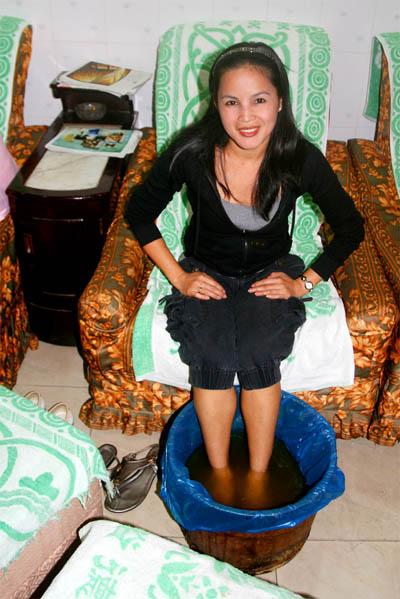
| We have earned a foot massage
|
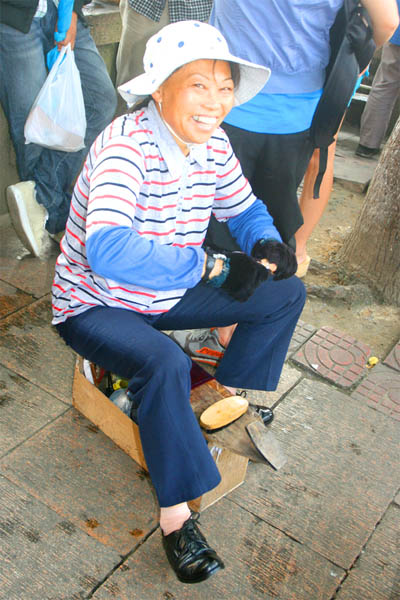
| but we don't need a shoeshine
|
Excursion to Zhujiajiao
Our Phoenix had some events, courses and excursions to offer. Some members of the staff acting as entertainers, instructors or guides, for free (and for the fun of it). All three of them combined in one person: Oliver. And more so: tending the bar, fixing sandwiches (even if slow) and serving breakfast on the rooftop, and ... organizing, improvising and conducting a trip to Zhujiajiao, one of the many canal towns west of Shanghai.
Firstly, we, seven travelers and five staff members, walked to a bus station in the People's Square. There, Oliver unfolded a blue flag which we all had to sign in order to create a group spirit and a symbol to follow in case we did get lost.
We were not the only one trying to get on the bus. One left full without us and on the next one half of our bunch had to stand, but the fare was cheap: 1.30 Euro for the more than one hour ride.
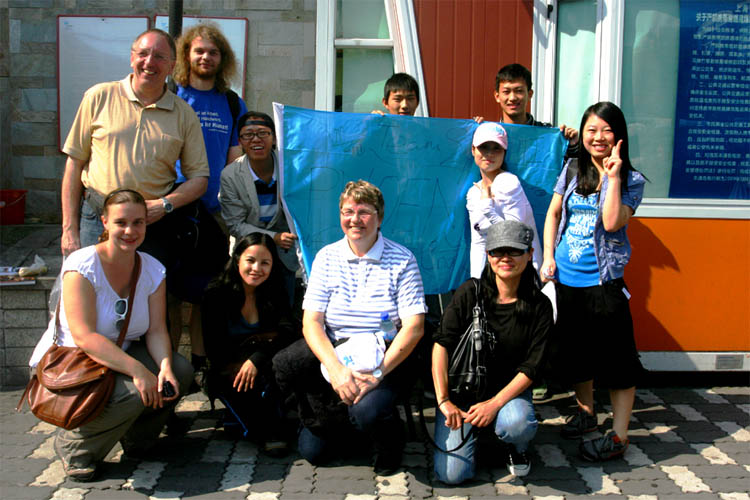
| Our bunch is ready
|
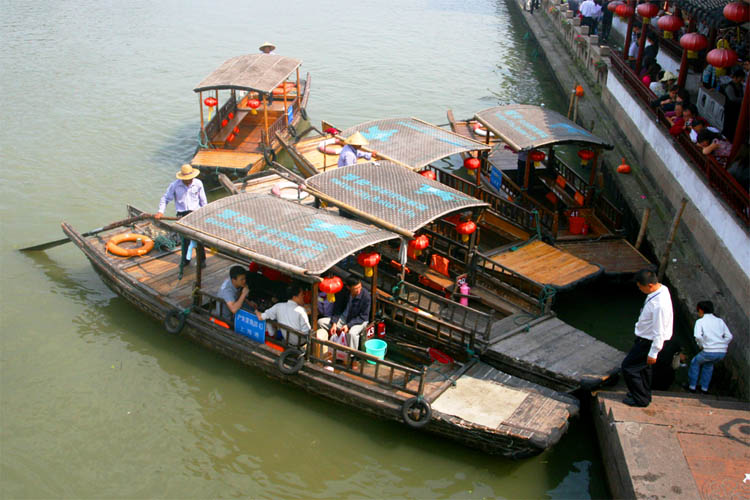
| to go to Little Venice
|
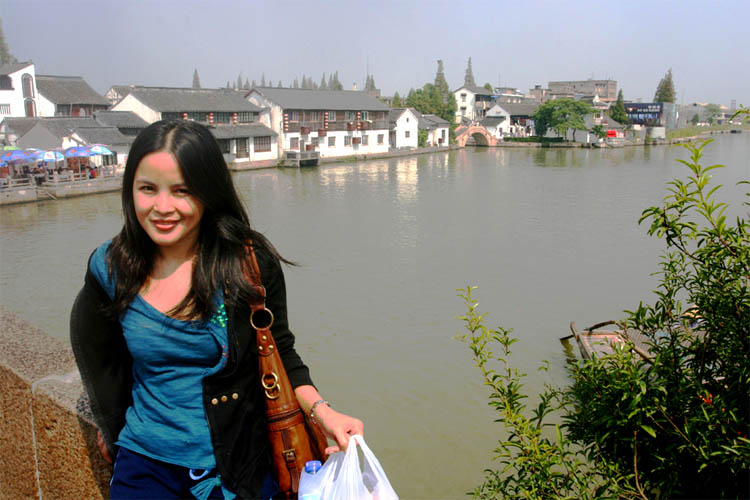
| This is a nice place
|
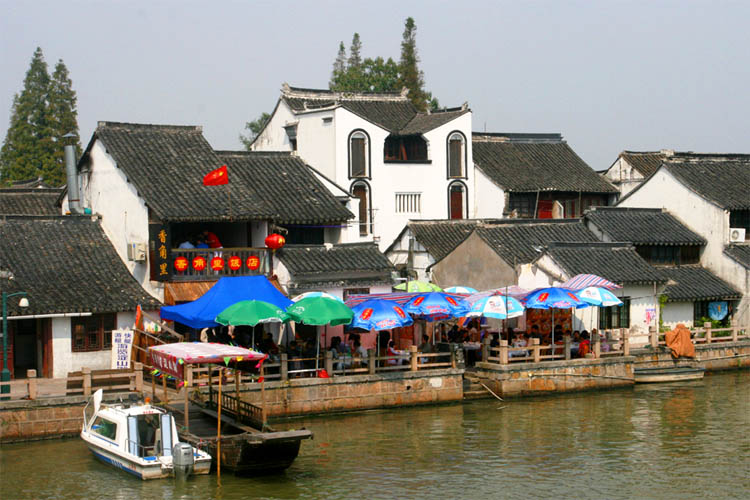
| out of Shanghai
|
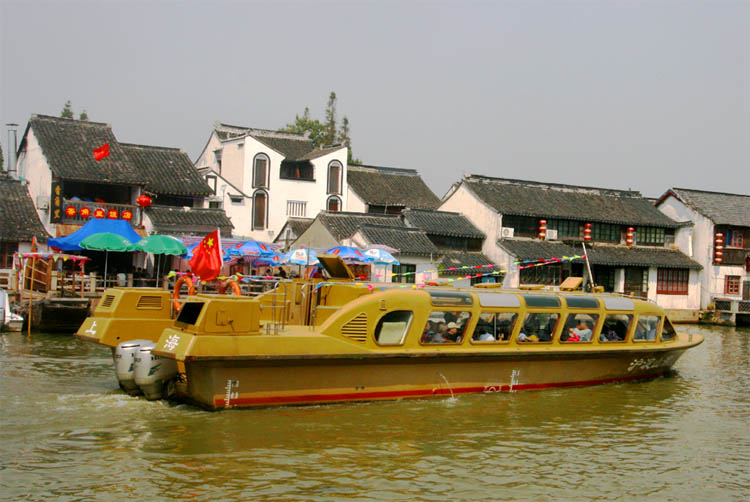
| Shall we take a gun boat
|
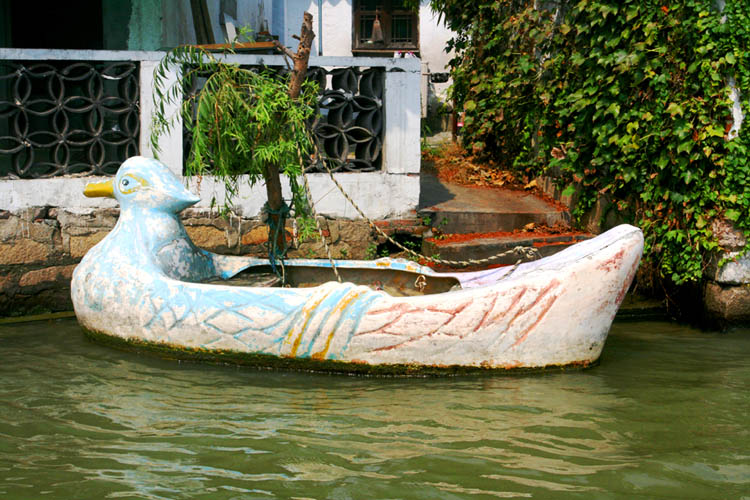
| or a duck boat for the cruise?
|
We decided to go on a Grande Canale Visita. The fare per person was 13 Euro (half price for the half tour). Nice price for half an hour. Up to six tourista fit on a gondola. Good income for the gondoliere (or the mafia?).
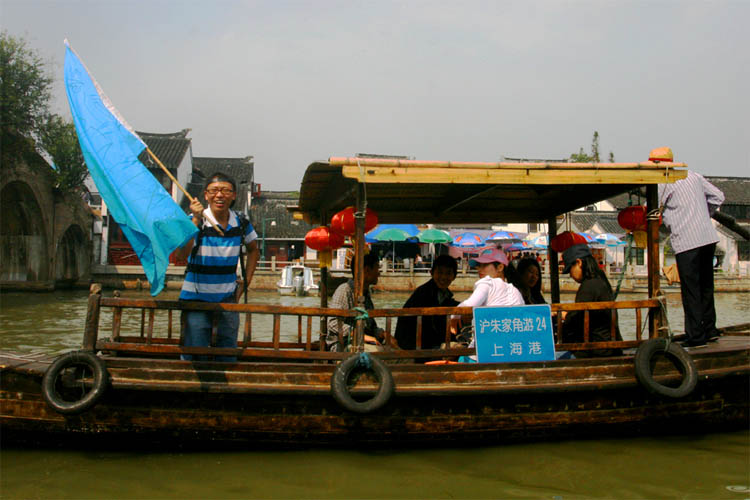
| Better take the antique barge
|
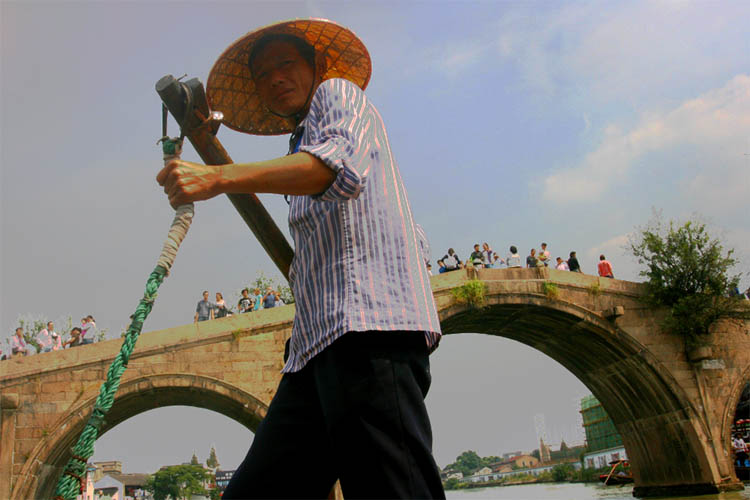
| moved forward with a paddle
|
The bridge you see next is called Fangsheng, not Feng Shui, but it still seemed to be very well balanced despite its age of over 400 years. Actually, the old canals with their towns around were built during the Ming Dynasty.
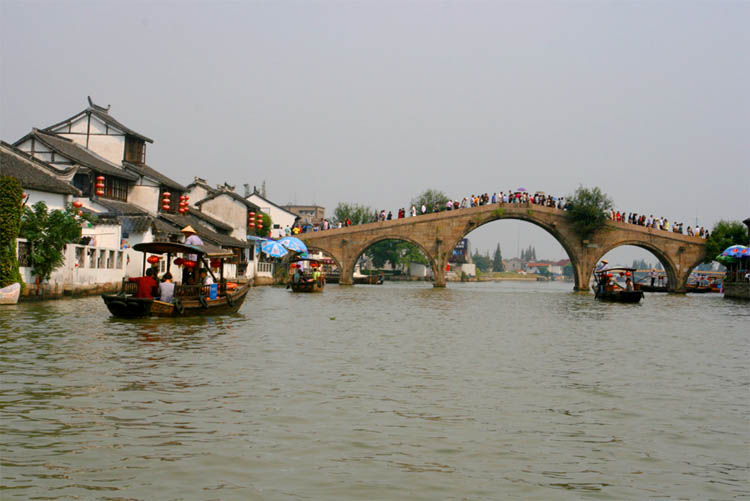
| The Fangsheng Bridge
|
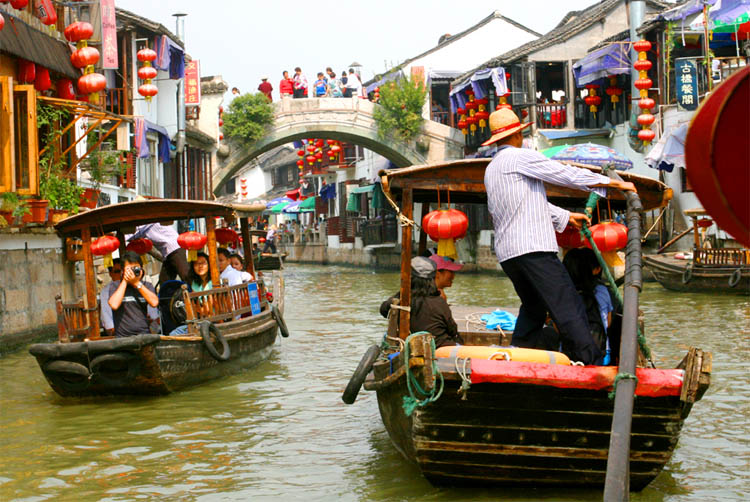
| The Rialto Bridge?
|

| Passing nice restaurants
|
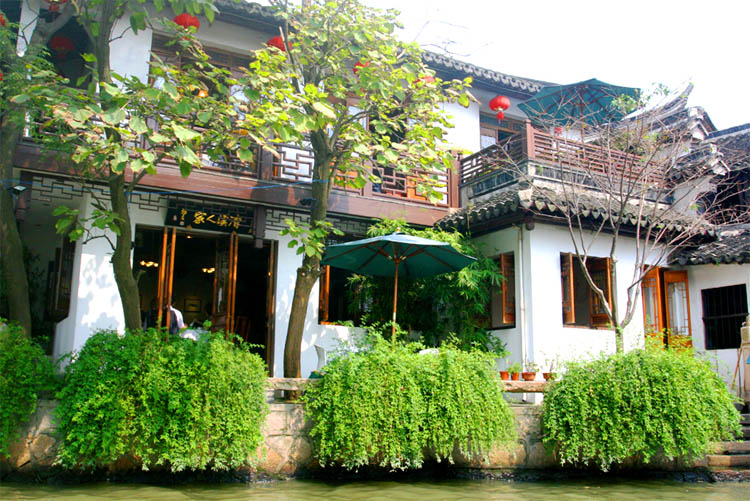
| in idyllic locations
|
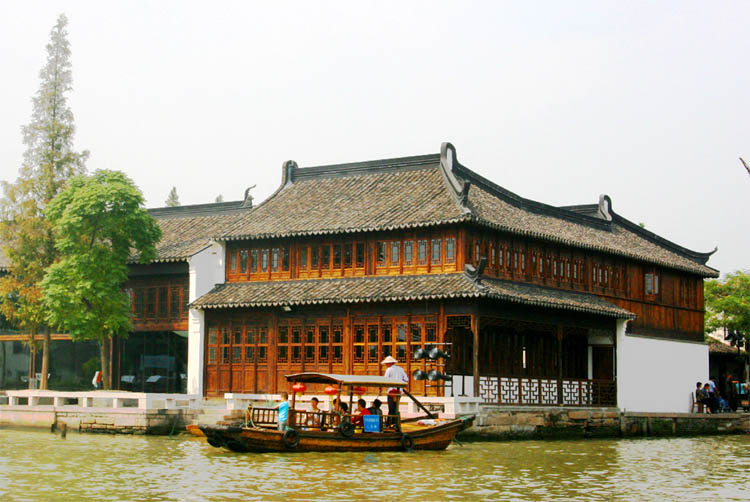
| A temple here
|
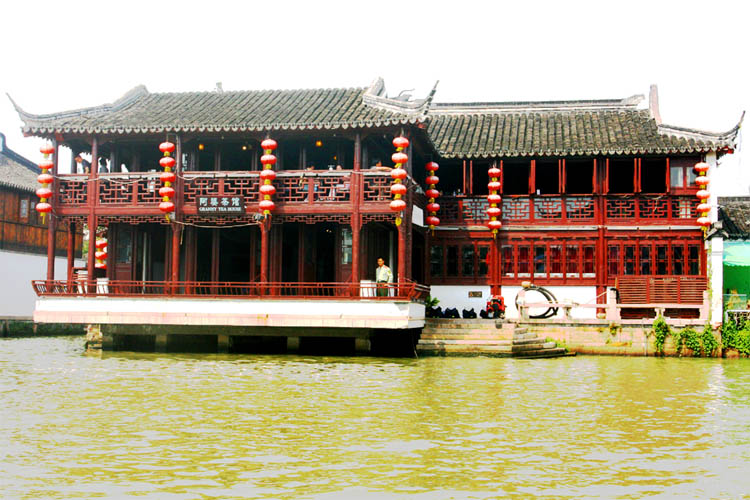
| A temple there
|
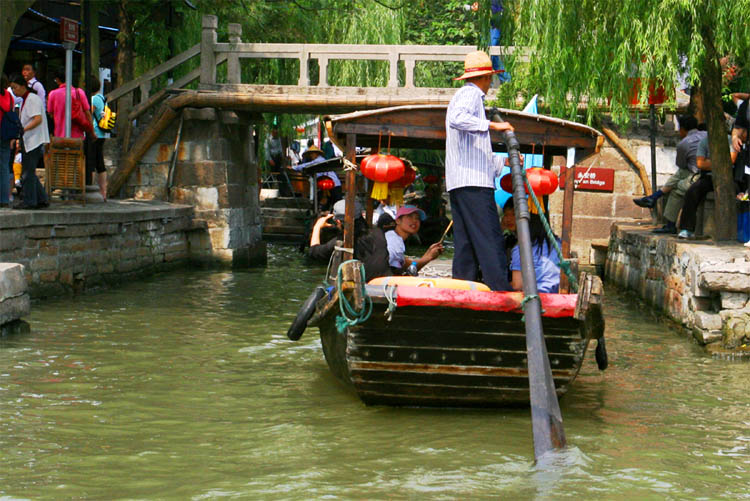
| Now we encounter a canal traffic jam
|

| better return and walk back again
|
It's nice to walk again, especially through the old back lanes of the old town to get an idea of how the people lived in the old days and partially up to now. Take a look yourself.
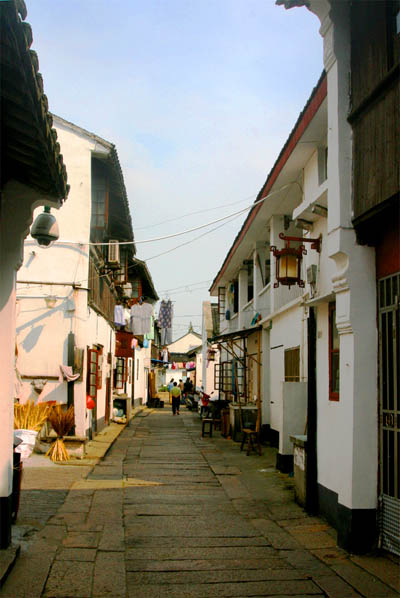
| Now finally: old village lane
|
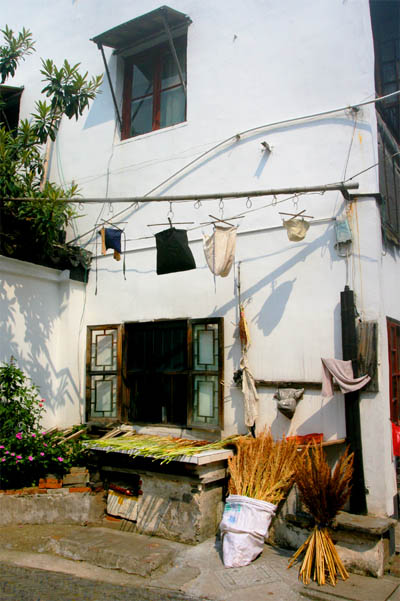
| with old backyards
|
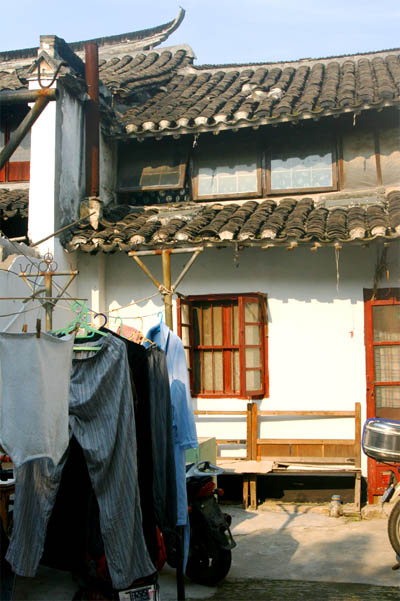
| Another back yard
|
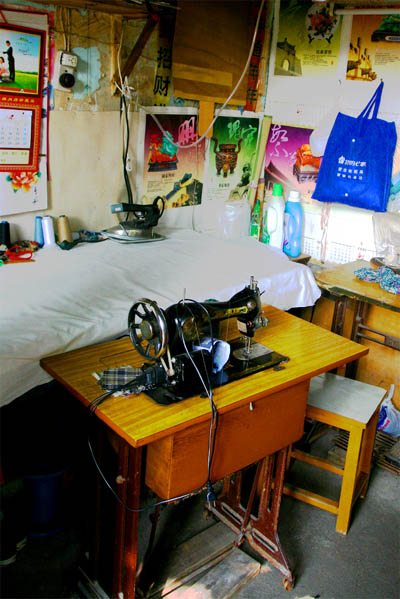
| Interior living quarter
|
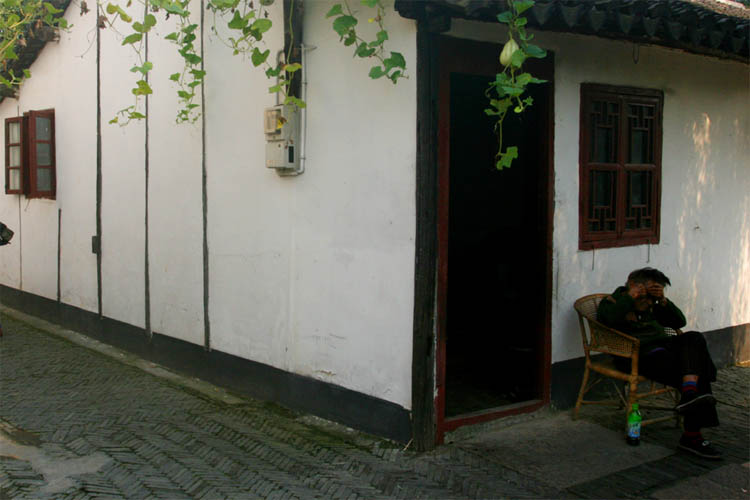
| This house looks newer
|

| but not the interior
|
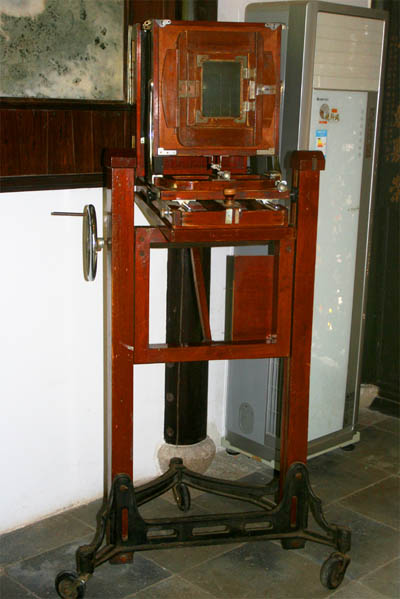
| This is inside of a better house
|

| where Mao is still being admired
|
Ok, then let's go back to where the action is: walking with the tourists along the canal to watch the boats and take a look at all these souvenir shops.

| Now we walk along the waterway
|
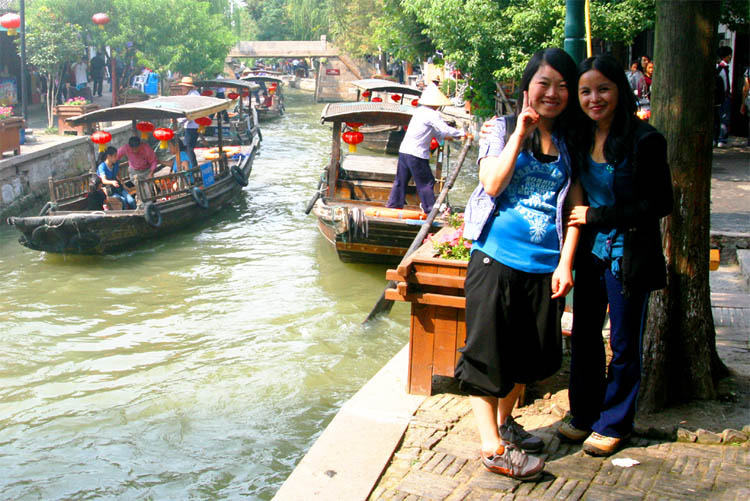
| with our friends from the Phoenix
|
And of course taking a look at all those many restaurants and cafés. Shall we eat a special mouth-watering Zhãròu, wrapped chunk of braised pork. Or if you are not up to a hearty meal than maybe a sweet treat in a nice café.
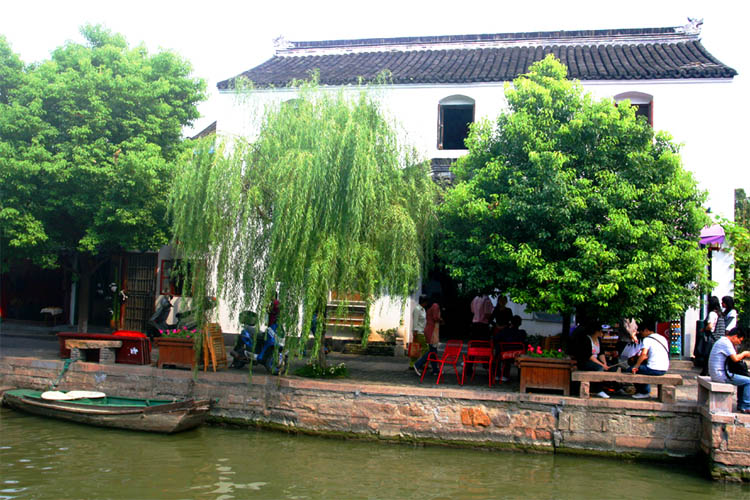
| Many restaurants
|
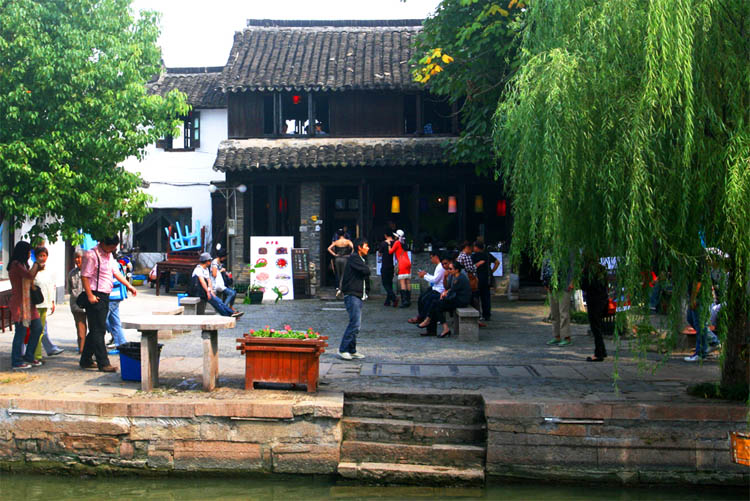
| along the waterway
|
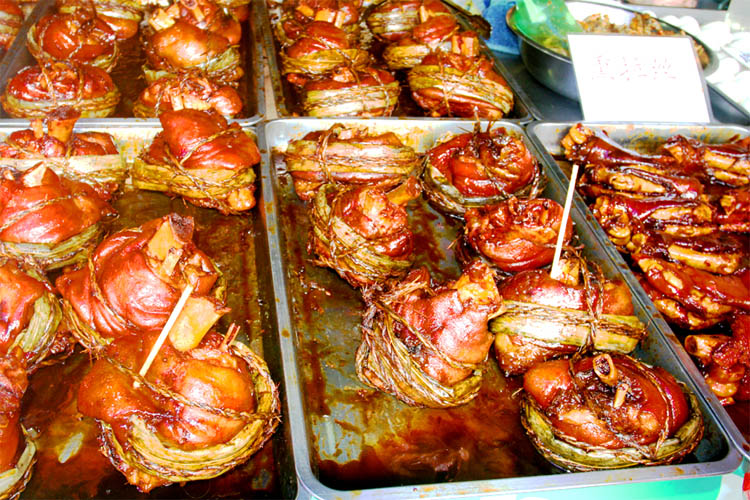
| These pork knuckles look delicious
|
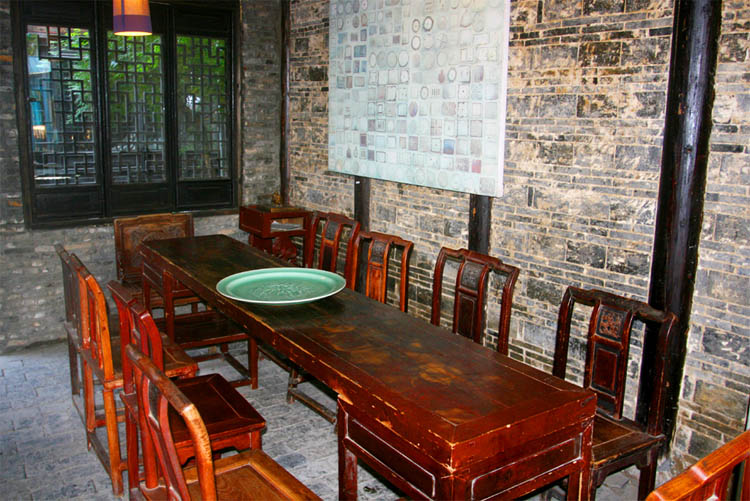
| but we rather stay in a café
|
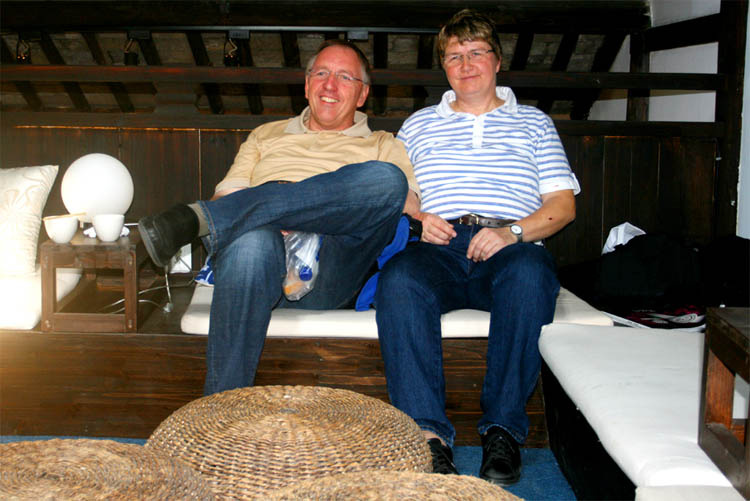
| Having a cappuccino
|

| and a piece of cake
|
Yes, it was a nice place up the stairs under the roof and to have two pieces of cake and a cappuccino and a café latte for 9.80 Euro. These were tourist prices, of course, but still cheaper than in old Venice in Italy.

| Looking out the window
|
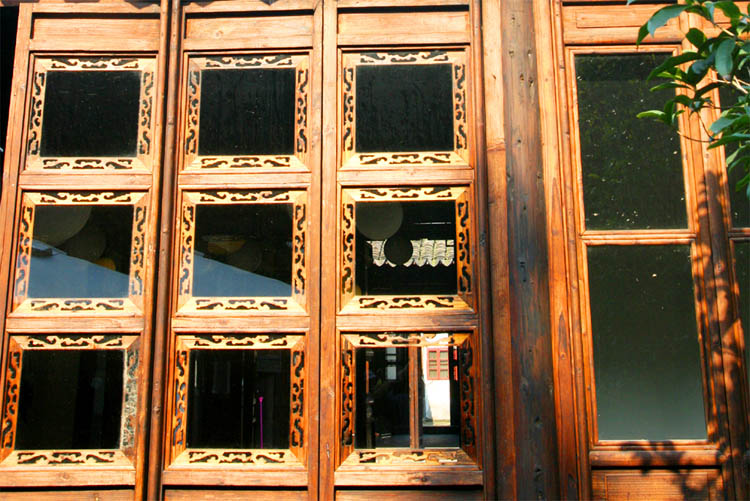
| and from the other side
|
Also the tasteful and expensive interior created a cozy atmosphere. But what about the exterior? Couldn't see much through the nicely carved cubicle windows. When we walking through the back door we saw an unusual still life in a very old back yard: Flower pots with greens on one side and on the other a toilet bowl with its cover as a clock on the wall, and a bench and chair to rest: art at its best.

| A naturally preserved court yard
|
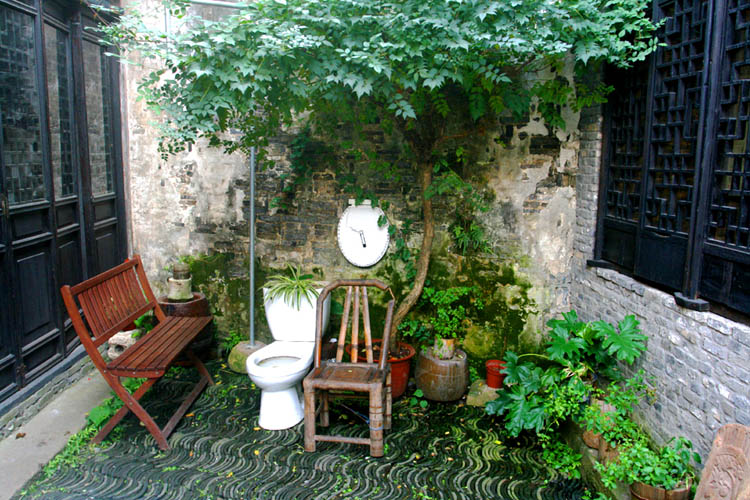
| with a bathroom for public viewing?
|
Ok, that was the final sight-seeing action in the canal town of Zhujiajiao. Had to get back to our bus station by walking the streets of the larger town along modern apartment buildings and some newer temples. But, oh my God, the bus station was full of people wanting to get on the one bus line back to Shanghai. We could squeeze into an already full one and thus were standing like sardines the whole trip back to the city. Maybe next time we take a sight-seeing tourist bus with reserved seats.
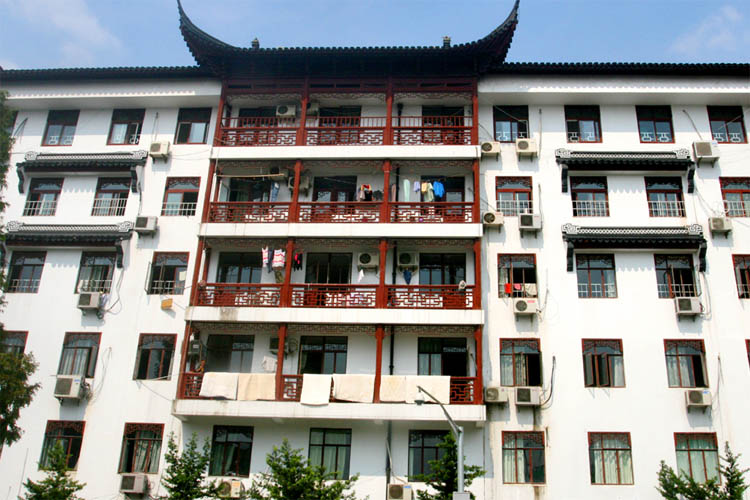
| Condo building looks like a temple
|
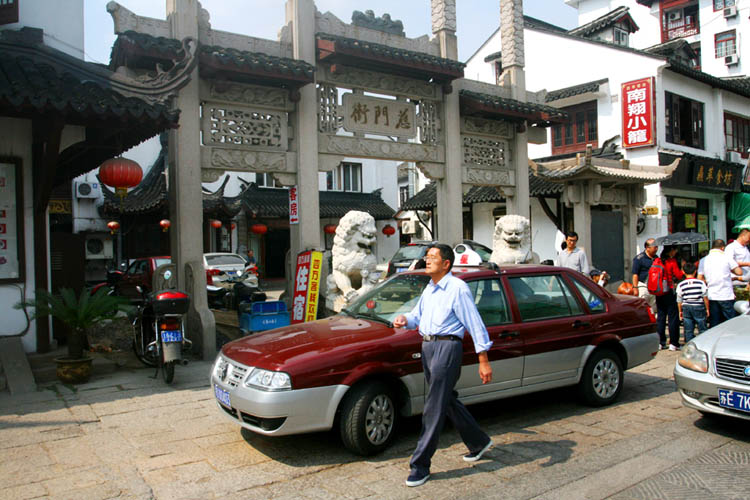
| This is really looking like a temple
|
If you want to skip now to the next part, then just hit
Part II
| 


















































































